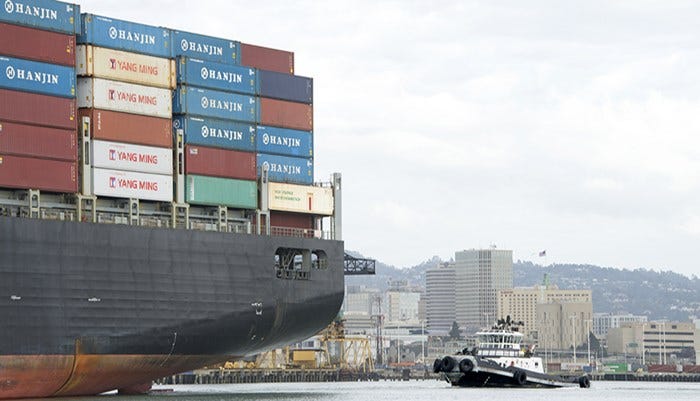Consolidation of Container Companies Impacts Hoosier Shippers
 Indiana shippers are concerned about the long-term impacts of the carrier consolidation trend.
Indiana shippers are concerned about the long-term impacts of the carrier consolidation trend.
Subscriber Benefit
As a subscriber you can listen to articles at work, in the car, or while you work out. Subscribe NowIndiana companies that ship internationally are navigating uncertain waters as they evaluate the ripple effects of the latest container shipping firm going bankrupt. South Korean carrier Hanjin filed for bankruptcy in the fall—the latest in a series of shakeups that have led international carriers to merge in an effort to survive a volatile market. Hoosier companies that move product on the ocean say the coming months will reveal the true impact of the consolidation trend on their daily operations.
FULLBEAUTY Brands imports most of its apparel and home goods products from Asia; 20 to 40-foot metal containers are stacked on shipping vessels and hauled across the ocean. The company is based in New York, but its logistics operations are headquartered in Indianapolis.
“The container shipping industry, overall, has been navigating in a pretty rough climate for the past two years or so,” says FULLBEAUTY Brands Executive Vice President of Operations Chip Edgington. “Slower international trade has created overcapacity in the industry—too many containers, too many vessels and not enough product to haul.”
In an effort to stay afloat, Edgington says the 11 largest competitors in the world have merged into three alliances. Hanjin’s bankruptcy in late 2016 was just the latest in a series, but the biggest in the container shipping industry since 1986.
Indianapolis-based Cargo Services Inc. is a freight forwarder that does “a tremendous amount of ocean freight shipping,” says Director of Global Sales Jefferson Clay. Hanjin’s bankruptcy had a direct impact on the company’s supply chain; some of Cargo Services’ customers had containers stranded at sea.
“It was a little bit of a nightmare to get [the containers] unloaded,” says Clay. “It took some time, and we had to wait for the government to intervene and try to help us out, and we did have to put some money out there to get unloaded.”
However, Clay says the company is more concerned about the long-term impacts of the carrier consolidation trend.
“For the short-term, it means rates will stay low, because there’s still too much capacity in the marketplace. For the long-term, as these consolidations or bankruptcies go through, you’ll see rates begin to creep up,” says Clay. “There’s less access to multiple options. It’s similar to, if there were only one flight out of Indianapolis to Chicago, then you’d have to pay whatever they want for that flight.”
Edgington says it would be naive to not be apprehensive about rising costs as a result of consolidations, but it’s not his chief concern.
“I’m personally more concerned about service options and delivery time in the first year,” says Edgington. “You’re talking about a lot of large shippers suddenly banding together, having to figure out what their trade routes are going to be and who’s going to be slighted with what vessels and where. There’s no way the transition period is going to go off without a hitch as they begin to align.”
Edgington expects the end of the first quarter and the second quarter will reveal the consolidation trend’s impact on service; because there will be fewer ships on the key routes, he’s anticipating fewer options.
“If service is impacted severely, you could have a situation that mirrors what happened two years ago; there were a lot of labor strikes in the Port of Long Beach [in Los Angeles], and there were ships waiting offshore that needed to be unloaded,” says Edgington. “That’s a severe example, but it points to the fact that, if there are service issues and there are less options, it becomes more challenging for importers and exporters to navigate around that.”
Clay believes the ripple effects of ocean liners consolidating will also likely impact the American consumer.
“A lot of what we buy here in the U.S. is made overseas, and a lot of it in Asia,” says Clay. “As the prices for transportation go up, and the capacity starts to meet demand, you’ll see the cost of individual goods you buy go up.”
Edgington says pricing in the container industry has always been “a roller coaster.” He expects the waters to calm in the spring, and companies can evaluate the real impact of fewer options for ocean cargo.
Edgington says it would be “naive” to assume the consolidation trend won’t impact costs.
Clay says shipping costs increasing could help keep more manufacturing jobs home in Indiana or the U.S.
